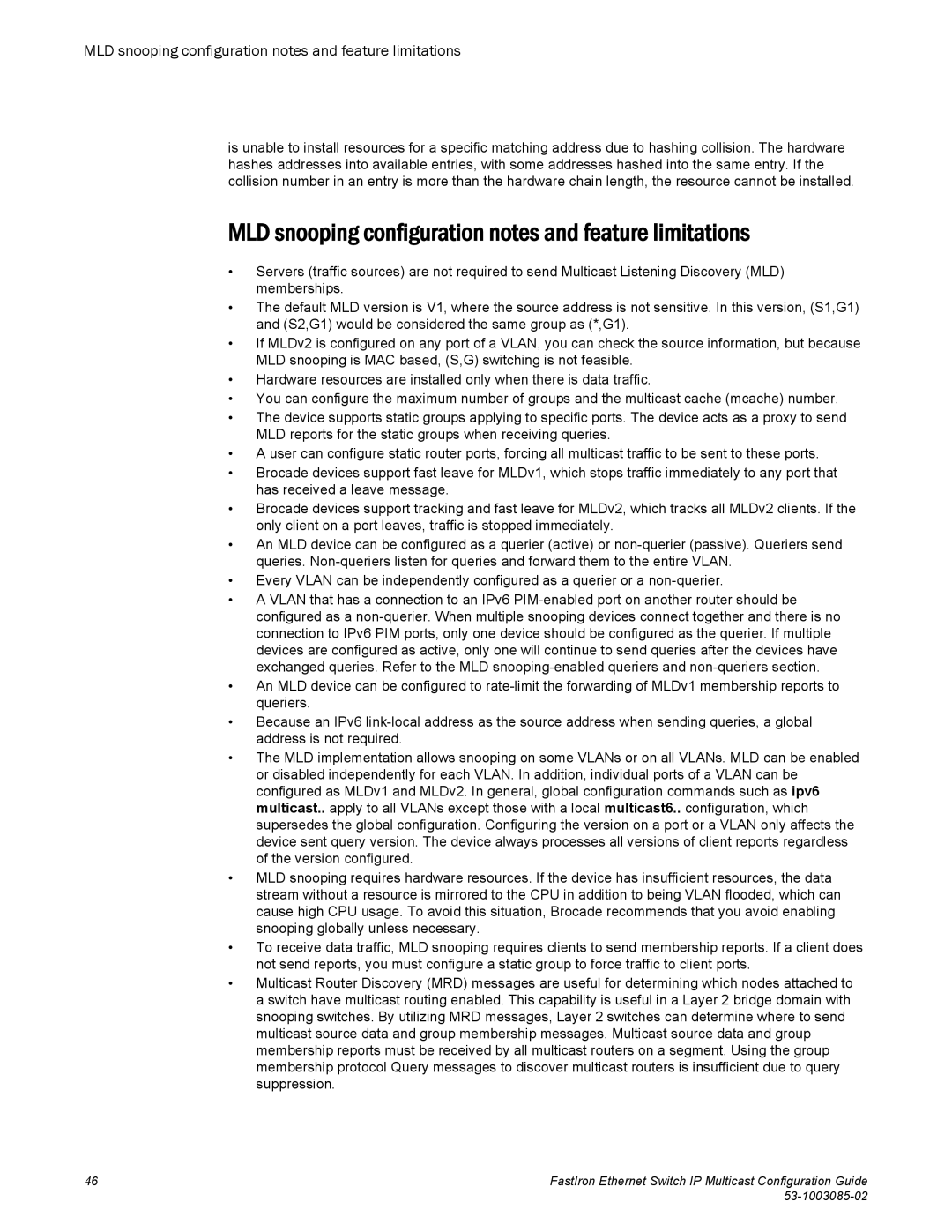MLD snooping configuration notes and feature limitations
is unable to install resources for a specific matching address due to hashing collision. The hardware hashes addresses into available entries, with some addresses hashed into the same entry. If the collision number in an entry is more than the hardware chain length, the resource cannot be installed.
MLD snooping configuration notes and feature limitations
•Servers (traffic sources) are not required to send Multicast Listening Discovery (MLD) memberships.
•The default MLD version is V1, where the source address is not sensitive. In this version, (S1,G1) and (S2,G1) would be considered the same group as (*,G1).
•If MLDv2 is configured on any port of a VLAN, you can check the source information, but because MLD snooping is MAC based, (S,G) switching is not feasible.
•Hardware resources are installed only when there is data traffic.
•You can configure the maximum number of groups and the multicast cache (mcache) number.
•The device supports static groups applying to specific ports. The device acts as a proxy to send MLD reports for the static groups when receiving queries.
•A user can configure static router ports, forcing all multicast traffic to be sent to these ports.
•Brocade devices support fast leave for MLDv1, which stops traffic immediately to any port that has received a leave message.
•Brocade devices support tracking and fast leave for MLDv2, which tracks all MLDv2 clients. If the only client on a port leaves, traffic is stopped immediately.
•An MLD device can be configured as a querier (active) or
•Every VLAN can be independently configured as a querier or a
•A VLAN that has a connection to an IPv6
•An MLD device can be configured to
•Because an IPv6
•The MLD implementation allows snooping on some VLANs or on all VLANs. MLD can be enabled or disabled independently for each VLAN. In addition, individual ports of a VLAN can be configured as MLDv1 and MLDv2. In general, global configuration commands such as ipv6 multicast.. apply to all VLANs except those with a local multicast6.. configuration, which supersedes the global configuration. Configuring the version on a port or a VLAN only affects the device sent query version. The device always processes all versions of client reports regardless of the version configured.
•MLD snooping requires hardware resources. If the device has insufficient resources, the data stream without a resource is mirrored to the CPU in addition to being VLAN flooded, which can cause high CPU usage. To avoid this situation, Brocade recommends that you avoid enabling snooping globally unless necessary.
•To receive data traffic, MLD snooping requires clients to send membership reports. If a client does not send reports, you must configure a static group to force traffic to client ports.
•Multicast Router Discovery (MRD) messages are useful for determining which nodes attached to a switch have multicast routing enabled. This capability is useful in a Layer 2 bridge domain with snooping switches. By utilizing MRD messages, Layer 2 switches can determine where to send multicast source data and group membership messages. Multicast source data and group membership reports must be received by all multicast routers on a segment. Using the group membership protocol Query messages to discover multicast routers is insufficient due to query suppression.
46 | FastIron Ethernet Switch IP Multicast Configuration Guide |
|
